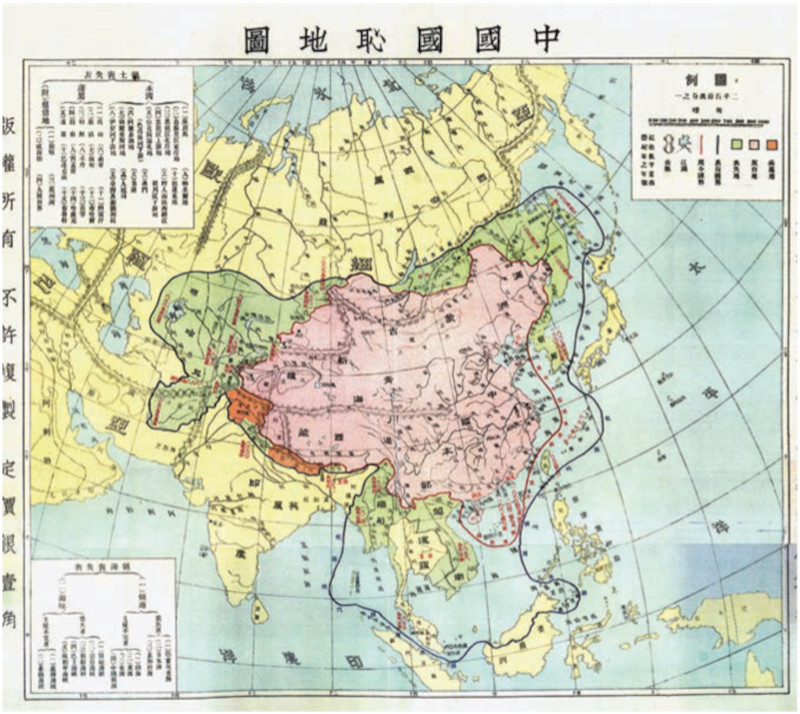The Taiwan issue is extraordinarily complex and sensitive for China (the People’s Republic of China, PRC), as it goes to the very root of the country’s extremely fragile modern identity. That identity arises at the intersection of imperial legacies, Western territorial ambitions and conceptions, and unarticulated practical considerations about the country’s security.
The Han issue of people and land
From Beijing, the argument is as follows. Han people make up some 95% of the Chinese population. However, about half of China’s present territory used to belong to minorities: Mongols, Tibetans, and Uyghurs (although now Han are the majority even there). If Taiwan, claimed by China and with a Han majority, is allowed independence, why can’t Mongols, Tibetans, and Uyghurs have their independence? There are no easy answers.
That is, giving up on Taiwan would push Beijing into a corner. Either it should grant massive concessions at home, or it would have to redefine what is “China”-PRC, which is also very complicated.
Then claiming Taiwan is the easy way out until that claim is challenged from outside.
The argument may have many faults, but at least we should be clear that for Beijing, Taiwan is not “Taiwan” but the PRC.
Giving up on Beijing’s claim on Taiwan calls into question Beijing’s claims over these other territories. It’s an existential issue for the PRC, and if so, it’s not about the legality of the claim, as much press has framed the issue, but it’s about the life or death of the PRC. Then where can we go from here?
We all need a comprehensive approach to China, not just picking on this today or on that tomorrow. And also, the PRC needs a massive comprehensive rethinking of its identity to survive; otherwise, it’ll be smothered by its contradictions.
With this comes many questions. The present PRC map, that includes Tibet, Xinjiang and Inner Mongolia, is based on the Qing (the imperial dynasty ruling the land from the middle of the 17th century until its fall in 1911) territorial claims.
Should the PRC give up on the territorial legacies of the Qing empire? If so, how to do it? But then, what about the Han living in Inner Mongolia, Tibet, or Xinjiang? And the thousands of problems coming from a reconfiguration of the Chinese territory?
Our failures, as foreigner observers, to provide a comprehensive and reasonable answer to the chain of issues raised by the disintegration of the post-Qing empire then makes many (not just the Beijing leaders) revert to a default position: Do nothing, don’t rock the boat, and try to bridge the gap with Taiwan incrementally.
We’d need a comprehensive answer if we are not happy with it. Shortcuts are dangerous.
Since a comprehensive answer is complicated, then what to do?
Personally, the hope is that a comprehensive answer should come from abroad, from China, or possibly from both.
Foreigners fed up
Still, realistically, foreigners are fed up with China and being entangled in its real or alleged, presumptuous and unfathomable difficulties. Therefore, they’ll go for shortcuts.
Knowing the difficulties and with vested interests in keeping its present borders and claims, China will argue for the status quo and against the “adventurism” of foreign suggested shortcuts.
Foreigners will then be torn between shortcuts and passive acceptance of the Chinese position. The possible answer is what is arguably happening now – the drifting of Western policies away from China’s standpoint (as is happening with Taiwan). This drift is almost parallel to Chinese drifting “expansion” on Hong Kong and the South China Sea.
Here, for the West, Beijing trampled on the agreement to keep Hong Kong intact for 50 years, and now it has thrashed local laws by applying Chinese regulations. On the South China Sea, by building military bases on the islands and strengthening its claim on the sea, China has shredded the ambiguity of the area, and de facto expanded its territory.
For China, Hong Kong was turning into a springboard of subversion of the Chinese mainland and had to be taken care of. In the South China Sea, Beijing stepped in because Malaysia and Vietnam were expanding their footprints, and if China didn’t do it, it’d lose it all.
The two logics are at odds with one another and are not interested in listening to each other for various reasons. One, the foreign, is based on the idea of an international order that has to be upheld; the other believes that its national interests trump anything else.
The contrast between the two drifts will increase over time with predictable, although unfortunate, consequences.
Without an available comprehensive approach, there is no way out of this.
A matter of visions
There is a deep-seated ideology behind this, that of “national humiliation,” described in many maps available in China and showing in detail all the territories lost.
William Callahan put it beautifully, explaining China’s territorial vision.
First, they graphically show the tension between the two ways of mapping China outlined above; they thus provide a colorful link between the cartographies of the imperial domain and sovereign territory. Second, they are deliberately published as part of patriotic education campaigns for public edification. In the Republican period these large wall maps of national humiliation were an essential part of the emergence of nationalist geography education in China; they were published by government bodies, geographic societies, and commercial presses for classroom use and public consumption alongside mainstream national maps. National humiliation maps published at the turn of the twenty-first century are likewise very public artifacts that are part of the PRC’s multimedia patriotic education campaign.
Third, national humiliation maps not only make expansive and aspirational claims to huge tracts of land as China’s national territory; they also address the enduring Chinese anxiety of falling apart… Indeed, many have noted that an obsession with unity is not simply a modern concern that arose in reaction to China’s tragic modern history, which is seen as a history of European, American, and Japanese imperialist aggression. While Euro-American philosophy asserts a solid objective reality that needs to be deconstructed, “in the Chinese case, in contrast, it is of a dispersed reality, in the face of which a reconstructive need has often struggled.” Similar national humiliation maps from the turn of the twenty-first century suggest that this search for “great unity” (da yitong) not only is part of China’s enduring political culture but continues to be one of the main theoretical frameworks for historical geography in the PRC.[1]
This builds into a three-pronged strategy for dealing with present territories:
The first strategy for claiming imperial possessions as national territory is to deny the difference between imperial domain’s hierarchical unbounded space and sovereign territory’s homogeneous bounded space. The second strategy is to establish the stories of China’s sovereign territoriality in the context of modern international politics – particularly colonialism – as opposed to China’s own history of imperial conquest. The third strategy is to read territoriality exclusively from Beijing’s point of view, and thus suppress any rival perspectives – from Lhasa, Kashgar, or Taibei – that might dispute the scope of China’s normative geobody. As we will see, Chinese cartography employs these three discursive strategies to essentialize the Qing dynasty’s imperial domain into the PRC’s national sovereign territory.[2]
The confusion and mix of the three elements (Western Westphalian and imperial maps, and the suppression of other visions) is the result of trying to digest/accept the Western vision and adapt it to the Chinese vision in an improved fashion for China, as if in a market to get a better bargain, and to spread the idea that we Chinese can’t take a loss (chi kui).
The root is a fundamental misunderstanding of the Western vision and Chinese history. It may be done with “good intentions” of improving China’s status in the world.
Still, because it fails to take into real consideration the foreigners in their visions, their claims, and the Chinese tradition, it goes nowhere and gets China in a lose-lose position, antagonizing abroad and promising undeliverables at home, thus dooming the cartographic propagandists.
It is a self-fulfilling trap for China. Because all these claims and visions, if not shared abroad, automatically create conflict between China and other countries.
One can argue that Western expansionist colonialism also imposed its worldview on other countries and ignored others’ claims. But colonialism took place two centuries ago. It was done based on complex ideologies that shared values with many different countries and hinged on a massive difference of power between colonizers and colonized.
Of course, others also misunderstood maps and claimed lost territories to expand. But when? In what conditions?
Japanese colonialism also happened in this way, with fascist elements all over the world supporting Japanese actions, while Tokyo was careful not to step on too many toes.
But Chinese ideas of self-interest do not have foreign support and can’t rely on a massive power difference between China and the other countries.
Moreover, there was an anticolonial attitude until the 1970s, that helped destroy old colonial empires. China can thus use that rhetoric and claim “lost territories” from old colonial powers, but you can’t be anticolonial and colonize others.
Then this confusion about its own situation and the external conditions and sentiments fails to satisfy Sunzi’s basic tenet “know yourself, know the other” (zhi ji, zhi bi).
Bracketed Taiwan or change of rhetoric?
Can Taiwan be put between brackets? Can nationalist rhetoric be toned down? It could give everyone breathing space and a little time to think more clearly.
In the meantime, besides geography, the political economy knocks at the door. China has a relatively closed economic and internal political system. It can sell and invest relatively freely abroad, but foreigners are not free to do the same in China.
Of course, this difference creates imbalances that grow with the size of the trade. Also, because of a drastic contraction of its domestic consumption, China may end this year with a whopping US $1 trillion surplus. This money comes basically all from G7 countries.
There is then a situation similar to the times before the Opium wars, exactly 200 years ago, when China was a massive exporter and a minimal importer. Such a situation can be tolerated for a short time; it’s unsustainable for a long time.
All of this, plus the geographic controversies and contradiction, create impossibly high volatility. Strong leadership can partly and temporarily contain it, but it is uncontrollable over time. Recently the Chinese leadership seems to have started to realize the difficulty of the position, but to slow down the machine running full throttle is very hard.
At the same time, there is no single person in command in the world out of China. There is not one man or a limited number of men that can move at will the sentiment built over at least a decade.
On the contrary, a growing consensus is consciously or unconsciously set de facto on a collision course. It’s impossible to swerve from the out of China.
If China doesn’t realize the full gravity of the situation and move accordingly, it could be tough to avoid a crash landing.
[1] William A. Callahan, “The Cartography of National Humiliation and the Emergence of China’s Geobody”, Public Culture 2009, 21-1 (141-173).
[2] William A. Callahan, “The Cartography of National Humiliation and the Emergence of China’s Geobody”, Public Culture 2009, 21-1 (141-173).







